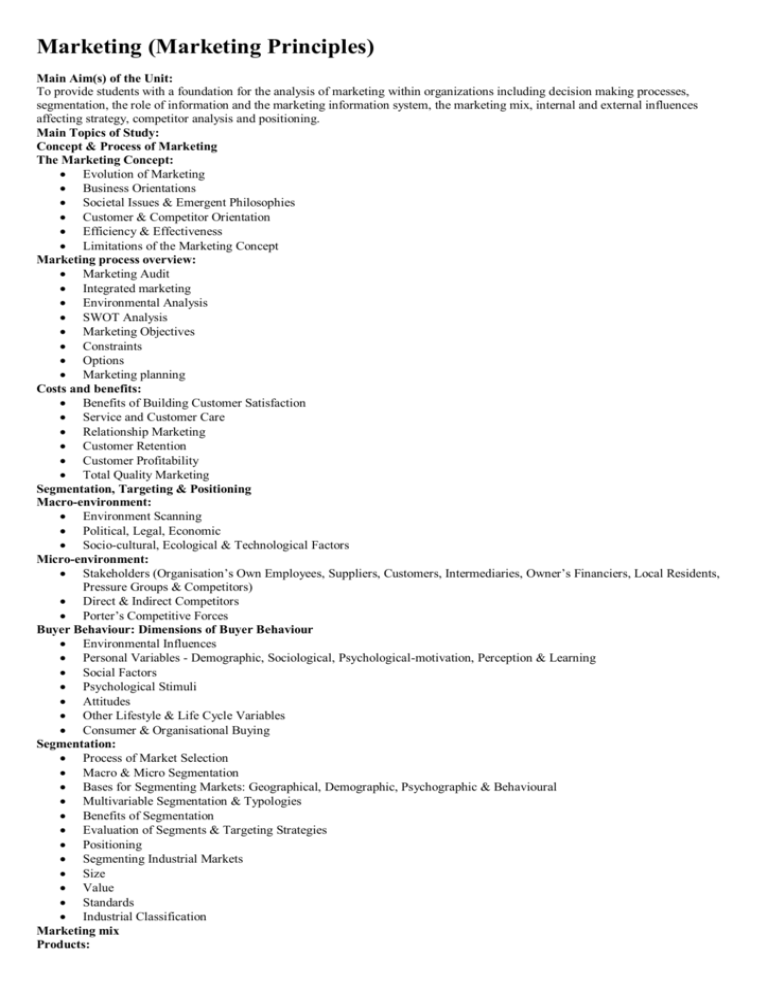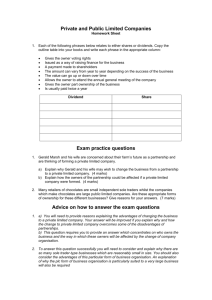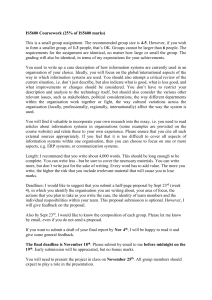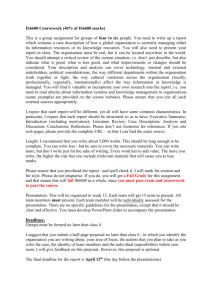Marketing (Marketing Principles)
advertisement

Marketing (Marketing Principles) Main Aim(s) of the Unit: To provide students with a foundation for the analysis of marketing within organizations including decision making processes, segmentation, the role of information and the marketing information system, the marketing mix, internal and external influences affecting strategy, competitor analysis and positioning. Main Topics of Study: Concept & Process of Marketing The Marketing Concept: Evolution of Marketing Business Orientations Societal Issues & Emergent Philosophies Customer & Competitor Orientation Efficiency & Effectiveness Limitations of the Marketing Concept Marketing process overview: Marketing Audit Integrated marketing Environmental Analysis SWOT Analysis Marketing Objectives Constraints Options Marketing planning Costs and benefits: Benefits of Building Customer Satisfaction Service and Customer Care Relationship Marketing Customer Retention Customer Profitability Total Quality Marketing Segmentation, Targeting & Positioning Macro-environment: Environment Scanning Political, Legal, Economic Socio-cultural, Ecological & Technological Factors Micro-environment: Stakeholders (Organisation’s Own Employees, Suppliers, Customers, Intermediaries, Owner’s Financiers, Local Residents, Pressure Groups & Competitors) Direct & Indirect Competitors Porter’s Competitive Forces Buyer Behaviour: Dimensions of Buyer Behaviour Environmental Influences Personal Variables - Demographic, Sociological, Psychological-motivation, Perception & Learning Social Factors Psychological Stimuli Attitudes Other Lifestyle & Life Cycle Variables Consumer & Organisational Buying Segmentation: Process of Market Selection Macro & Micro Segmentation Bases for Segmenting Markets: Geographical, Demographic, Psychographic & Behavioural Multivariable Segmentation & Typologies Benefits of Segmentation Evaluation of Segments & Targeting Strategies Positioning Segmenting Industrial Markets Size Value Standards Industrial Classification Marketing mix Products: Products & Brands - Features, Advantages & Benefits The Total Product Concept Product Mix Product Life-cycle & Its Effect on Other Elements of the Marketing Mix Product Strategy New Product Development Adoption Process Place: Customer Convenience & Availability Definition of Channels Types & Functions of Intermediaries Channel Selection Integration & Distribution Systems Franchising Physical Distribution Management & Logistics Ethical Issues Price: Perceived Value Pricing Context & Process Pricing Strategies Demand Elasticity Competition Costs Psychological Discriminatory Ethical Issues Promotion: Awareness & Image Effective Communication Integrated Communication Process Promotional Mix Elements Push & Pull Strategies Advertising Above & Below the Line Packaging Public Relations & Sponsorship Sales Promotion Direct Marketing & Personal Selling Branding On-line Marketing Different Marketing Segments & Contexts Consumer Markets: Fast-moving Consumer Goods Consumer Durables Co-ordinated Marketing Mix to Achieve Objectives Organisational Markets: Differences From Consumer Markets Adding Value Through Service Industrial Non-profit Making Government Re-seller Services: Nature & Characteristics of Service Products - Intangibility, Ownership, Inseparability, Perishability, Variability Heterogeneity - the 7Ps Strategies Service Quality Elements of Physical Product Marketing Tangible & Intangible Benefits International Markets: Globalisation Standardisation Versus Adaptation The EU / Benefits & Risks Market Attractiveness International Marketing Mix Strategies Learning Outcomes for the Unit At the end of this Unit, students will be able to: 1. Understand the marketing environment and the scope of tasks undertaken in marketing in the context of different organizational situations in which marketing is applied. 2. Understand the decision making processes within consumer and organizational buying situations explain the ways in which market segments are defined and recognise the importance of information in decisions concerning customers and markets. 3. Assess the role of the marketing mix within the context of marketing decision making. 4. Examine various marketing strategies used within different organizations and competitive situations Learning and teaching methods/strategies used to enable the achievement of learning outcomes: Learning takes place on a number of levels through lectures, class discussion including problem review and analysis. Formal lectures provide a foundation of information on which the student builds through directed learning and self managed learning outside of the class. The students are actively encouraged to form study groups to discuss course material which fosters a greater depth learning experience. Assessment methods which enable student to demonstrate the learning outcomes for the Unit: Examination: 3 hours duration 100% Indicative Reading for this Unit: Main Text: Marketing: HND Mandatory Unit 1. BPP Professional Education ISBN 0-7517-1243-4 Please upgrade your browser Alternative Texts and Further Reading: Fundamentals of Marketing - W G Leader & N Kyritsis (Stanley Thorne) Marketing Principles and Practice – D Adcock (Pearson Publishing) Principles of Marketing - Kotler (Prentice Hall) Please upgrade your browserPlease upgrade your browserPlease upgrade your browser Guideline for Teaching and Learning Time (10 hrs per credit) 50 hours Lectures / Seminars / Tutorials / Workshops Tutorial support includes feedback on assignments and may vary by college according to local needs and wishes. 50 hours Directed learning Advance reading and preparation / Class preparation / Background reading / Group study / Portfolio / Diary etc 100 hours Self managed learning Working through the course text and completing assignments as required will take up the bulk of the learning time. In addition students are expected to engage with the tutor and other students and to undertake further reading using the web and/or libraries. MARCH 2011 MARKETING PRINCIPLES (MARKETING) Instructions to candidates: a) Time allowed: Three hours (plus an extra ten minutes’ reading time at the start – do not write anything during this time) b) Answer any FIVE questions c) All questions carry equal marks. Marks for each question are shown in [ ] 1. a) b) Define and explain the THREE specific challenges facing marketers of services. Define and explain the FOUR characteristics of services. [10] [10] 2. a) b) Define the term organisational/industrial buying. What are the FOUR main forces influencing the organisational buyer? [5] [15] 3. Define and explain with an example the following terms: a) Brand preference b) Brand loyalty c) Brand switching d) Brand positioning Explain what is meant by the term marketing communications. Effective marketing communications is essential. In terms of personal selling how can it all go wrong? [5] [5] [5] [5] 4. a) b) [5] [15] 5. In order for a product to be distributed, FIVE basic functions need to be fulfilled. Describe with examples EACH of these five functions. [4 for each function] 6. Provide a definition of the following terms with supporting examples: a) Product cost b) Direct cost c) Indirect cost d) Fixed cost [5] [5] [5] [5] 7. Explain with examples the strengths and weaknesses of using direct mail. [20] 8. a) b) [15] [5] Explain why a company might want to enter into international marketing. Why might a company avoid involving themselves in international marketing? MAY 2011 MARKETING PRINCIPLES (MARKETING) Instructions to candidates: a) Time allowed: Three hours (plus an extra ten minutes’ reading time at the start – do not write anything during this time) b) Answer any FIVE questions c) All questions carry equal marks. Marks for each question are shown in [ ] 1. a) b) Define the term the marketing concept. [5] Discuss briefly, using the marketing concept, an organisation that has taken into account this concept, and one that has not. [15] 2. a) b) What is meant by the term relationship marketing? Discuss both the stages and content of a customer care strategy. 3. Porter (1996) identifies FIVE competitive forces that influence the state of competition in an industry. Select TWO of these forces and discuss with examples what these mean. [20] 4. a) b) Define the term consumer buying behaviour using an example of your choice. Explain the general stages in the buying process. [5] [15] 5. a) b) Define the term culture as it relates to marketers. Using a country of your choice, explain and discuss what is meant by a micro culture. [5] [15] 6. a) 7. a) b) 8. What are the major determinants of service quality? Use an example to illustrate your answer. [5] [15] There are a number of functions usually needed to be fulfilled for a product to be distributed. Explain EACH of these functions. [10] b) In setting up a channel of distribution, the supplier has to consider FIVE factors. Explain with an example the five factors. [10] Using an example of your choice, define the terms ‘push’ and ‘pull’ strategies. Discuss the main objectives of an advertising campaign. [8] [12] [20] JUNE 2011 MARKETING PRINCIPLES (MARKETING) Instructions to candidates: a) Time allowed: Three hours (plus an extra ten minutes’ reading time at the start – do not write anything during this time) b) Answer any FIVE questions c) All questions carry equal marks. Marks for each question are shown in [ ] 1. a) b) 2. When setting prices, companies must think about a number of factors. Using an example of your choice, explain what these factors should be. [20] 3. There are broadly three types of stakeholder. Who are these stakeholders, and what interests do they seek to defend? [20] 4. Over the past 30 years the Green Movement has had an increasing effect on marketing. a) What impact has the concern for the environment had on marketing practices? b) What types of activities have green pressure groups used on businesses to achieve their aims? [10] [10] 5. Using an example of your choice, explain the Ansoff matrix. [20] 6. a) b) Describe the ways ‘price discrimination’ can be exercised. Describe FIVE ways of discounting. [10] [10] 7. a) b) Describe the features of fast-moving consumer goods (FMCGs). i Define the term consumer goods. ii Explain how consumer goods can be classified. [10] 8. a) b) Using an example of your choice, explain the advantages of a ‘marketing orientation’. Using an example of your choice, explain the limitations of a ‘marketing orientation’. Define the term not-for-profit organisation. Explain what is meant by the term the extended marketing mix in relation to a charity or a not-for-profit organisation of your choice. [10] [10] [10] [5] [15] SEPTEMBER 2011 MARKETING PRINCIPLES (MARKETING) Instructions to candidates: a) Time allowed: Three hours (plus an extra ten minutes’ reading time at the start – do not write anything during this time) b) Answer any FIVE questions c) All questions carry equal marks. Marks for each question are shown in [ ] 1. Using an example of your choice, explain the advantages and disadvantages of: a) a marketing orientation b) a sales orientation [20] 2. a) b) Define the term marketing management. Using an example of your choice, explain the FOUR aspects of marketing management. [5] [15] 3. a) b) Explain the methods the marketer could use to segment the industrial market. [10] Lifestyle refers to the distinctive ways of living adopted by particular communities or sub-sections of society. Explain with examples the FOUR categories of the concept of lifestyle. [10] 4. The main aim of direct marketing is to acquire and retain customers. Explain the SEVEN processes that need to be addressed. [20] 5. a) b) 6. What are the weapons in the salesperson’s armoury that would enable them to persuade the buyer to buy their product or service? [20] 7. a) b) What are the characteristics of industrial markets? [5] Industrial products are distinctive in a number of ways. Use an example to explain how industrial products are distinctive. [15] 8. a) b) Define the term international marketing. [5] What are the FIVE suggested approaches to the problem of adaptation which are defined by decisions about the product and about promotion? [15] Define the term telemarketing. Explain with an example the benefits of telemarketing. [5] [15] DECEMBER 2011 MARKETING PRINCIPLES (MARKETING) Instructions to candidates: a) Time allowed: Three hours (plus an extra ten minutes’ reading time at the start – do not write anything during this time) b) Answer any FIVE questions c) All questions carry equal marks. Marks for each question are shown in [ ] 1. Provide a brief definition and example to explain the following marketing concepts: a) Consumer research b) Production orientation c) Product orientation d) Product differentiation [5 each] 2. Describe the range of responsibilities to the stakeholders in an organisation. [20] 3. a) b) Define what is meant by the term marketing audit. What are the marketing activities a market audit would concentrate on? [5] [15] 4. a) b) Explain, using examples, THREE categories of forecasting methods. What are the THREE basic ways in which forecasts can be made? [12] [8] 5. a) b) c) Define what is meant by the term a product. A product is said to possess TWO attributes. Explain the features of EACH attribute. How can consumer goods be classified? [4] [12] [4] 6. a) b) Using an example of your choice, explain the Product Life Cycle (PLC). Explain the Boston Consulting Group (BCG) matrix, and why it is useful. [10] [10] 7. a) b) What are the advantages and disadvantages of personal selling? Describe the purpose of a Key Accounts Manager in an organisation. [10] [10] 8. a) b) What are the strengths and weaknesses of direct mail? What are the benefits of telemarketing? [10] [10]








